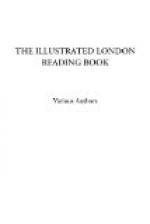The grain which they chiefly cultivate is a kind of millet: a small quantity of Indian corn and some pumpkins are likewise grown; but a species of sugar-cane is produced in great abundance, and of this they are extremely fond. Their diet, however, is chiefly milk in a sour curdled state. They dislike swine’s flesh, keep no poultry, are averse to fish, but indulge in eating the flesh of their cattle, which they do in a very disgusting way. Although naturally brave and warlike, they prefer an indolent pastoral life, hunting being an occasional pastime.
Much light was thrown on the condition and future prospects of this people in 1835, by some papers relative to the Cape of Good Hope, which were laid before the English Government. From these it appeared that a system of oppression and unjustifiable appropriation on the part of the whites, have from time to time roused the savage energies of the Kaffirs, and impelled them to make severe reprisals upon their European spoilers. The longing of the Cape colonists for the well-watered valleys of the Kaffirs, and of the latter for the colonial cattle, which are much superior to their own, still are, as they have always been, the sources of irritation. Constant skirmishes took place, until, at length, in 1834, the savages poured into the colony in vast numbers, wasted the farms, drove off the cattle, and murdered not a few of the inhabitants. An army of 4000 men was marched against the invaders, who were driven far beyond the boundary-line which formerly separated Kaffirland from Cape Colony, and not only forced to confine themselves within the new limits prescribed, but to pay a heavy fine. Treaties have been entered into, and tracts of country assigned to the Kaffir chiefs of several families, who acknowledge themselves to be subjects of Great Britain, and who are to pay a fat ox annually as a quit-rent for the lands which they occupy.
Macomo, one of the Kaffir Chiefs, is a man of most remarkable character and talent, and succeeded his father, Gaika, who had been possessed of much greater power and wider territories than the son, but had found himself compelled to yield up a large portion of his lands to the colonists. Macomo received no education; all the culture which his mind ever obtained being derived from occasional intercourse with missionaries, after he had grown to manhood. From 1819, the period of Gaika’s concessions, up to the year 1829, he with his tribe dwelt upon the Kat river, following their pastoral life in peace, and cultivating their corn-fields. Suddenly they were ejected from their lands by the Kat river, on the plea that Gaika had ceded these lands to the colony. Macomo retired, almost without a murmur, to a district farther inland, leaving the very grain growing upon his fields. He took up a new position on the banks of the river Chunice, and here he and his tribe dwelt until 1833, when they were again driven out to seek a new home, almost without pretence. On this occasion Macomo did make a remonstrance, in a document addressed to an influential person of the colony. “In the whole of this savage Kaffir’s letter, there is,” says Dr. Philip, “a beautiful simplicity, a touching pathos, a confiding magnanimity, a dignified remonstrance, which shows its author to be no common man. It was dictated to an interpreter.”




